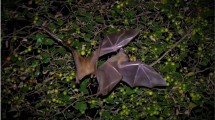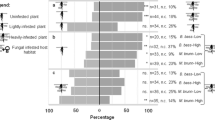Abstract
Fruiteating bats are important seed dispersers in tropical forests. Olfaction seems to be the main sense used by these bats to locate and select food. Previous studies have demonstrated that they identify and select volatile organic compounds, being able to track essential oils of their preferred fruits. However, the specific role played by different compounds in this attraction is largely unknown. Here, we used chromatographic analysis and attraction trials to investigate the molecular basis of foragingin two Neotropical bat species. Both were able to discriminate two classes of compounds, monoterpenes and sesquiterpenes. We suggest that the first class provide the initial signal as they are released only in early stages and the second group is formed by less volatile compounds released in later stages and responsible for maintaining bat interest even in the absence of monoterpenes. These findings provide a unique molecular perspective for this mutualistic interaction with important implications in forest restoration. Specifically, simple mixtures of commercially available terpenes could act as attractants to seeddispersing bats into degraded landscapes.
Similar content being viewed by others
References
Adams, R.P., 2007. Identification of Essential Oil Components By Gas Chromatography/Mass Spectrometry, 4th ed. Allured Publishing Corporation, Carol Stream.
Altmann, J., 1974. Observational study of behavior: sampling methods. Behavior 59, 227–266.
Altringham. J.D., 2011. Bats: from Evolution to Conservation, 2nd ed. Oxford University Press, New York.
Baldwin, I.T., Halitschke, R., Paschold, A., Dahl, C.C., Von Preston, CA., 2006. Volatile signaling in plantplant interactions: “Talking trees” in the genomics era. Science 311, 812–815, https://doi.org/10.1126/science.1118446.
Bhatnagar, K.P., 1975. Olfaction in Artibeus jamaicensis and Myotis lucifugus inthe context of vision and echolocation. Experientia 272, 856.
Bhatnagar, K.P., Kallen, F.C., 1975. Quantitative observations on the nasál epithelia and olfactory innervation in bats. Suggested design mechanisms for the olfactorybulb.ActaAnat. 91, 272–282.
Bianconi, G.V., Mikich, S.B., Teixeira, S.D., Maia, B.H.L.N.S., 2007. Attraction of fruiteating bats with essential oils of fruits: a potential tool for forest restoration. Biotropica 39, 136–140, https://doi.org/10.1111/j.1744-7429.2006.00236.x.
Bianconi, G.V., Suckow, U.M.S., Cruz-Neto, A.P., Mikich, S.B., 2012. Use of fruit essential oils to assist forest regeneration by bats. Restor. Ecol. 20, 211–217, https://doi.org/10.1111/j.1526-100X.2010.00751.x.
Borges, R.M., Bessiěre, J.M., Hossaert-McKey, M., 2008. The chemical ecology of seed dispersal in monoecious and dioecious flgs. Funct. Ecol. 22, 484–493, https://doi.org/10.1111/j.1365-2435.2008.01383.x.
Carter, G.G., Ratcliffe, J.M., Galef, B.G., 2010. Flower bats (Glossophaga soríána) and fruit bats (Carollia perspicillata) rely on spatial cues over shapes and scents when relocating food. PLoS One 5, 1–6, https://doi.org/10.1371/journal.pone.0010808.
Dudareva, N., Negre, F., Nagegowda, D.A., Orlova, I., 2006. Plant Volatiles: Recent Advances and Future Perspectives. CRC Crit. Rev. Plant Sci. 25, 417–440, https://doi.org/10.1080/07352680600899973.
Dudareva, N., Klempien, A., Muhlemann, J.K., Kaplan, I., 2013. Biosynthesis, function and metabolic engineering of plant volatile organic compounds. New Phytol. 198, 16–32, https://doi.org/10.1111/nph.12145.
Handley, CO., Wilson, D.E., Gardner, A.L., 1991. Demography and natural history of the common fruit bat, Artibeus jamaicensis, on Barro Colorado Island, Panamá. Smithson. Contrib. Zool., 1–173, https://doi.org/10.5479/si.00810282.511.
Hodgkison, R., Ayasse, M., Kalko, E.K.V., Haberlein, C., Schulz, S., Mustapha, W.A.W., Zubaid, A., Kunz, T.H., 2007. Chemical ecology of fruit bat foraging behavior in relation to the fruit odors of two species of paleotropical batdispersed flgs (Ficus hispida and Fícus scortechinii). J. Chem. Ecol. 33, 2097–2110, https://doi.org/10.1007/sl0886-007-9367-1.
Hodgkison, R., Ayasse, M., Haberlein, C., Schulz, S., Zubaid, A., Mustapha, W.A.W., Kunz, T.H., Kalko, E.K.V., 2013. Fruit bats and bat fruits: the evolution of fruit scent in relation to the foraging behaviour of bats in the New and Old World tropics. Funct. Ecol. 27, 1075–1084, https://doi.org/10.1111/1365-2435.12101.
Jones, K.E., Bininda-Emonds, O.R.P., Gittleman, J.L., 2005. Bats, clocks, and rocks: diversiflcation patterns in Chiroptera. Evolution (N. Y.) 59, 2243–2255.
Kalko, E.K.V., Handley Jr, CO., Handley, D., 1996. Organization, diversity, and longterm dynamics of a Neotropical bat community. In: Cody, M., Smallwood, J. (Eds.), LongTerm Studies of Vertebrate Communities. Academie Press, Los Angeles, pp. 503–553, https://doi.org/10.1016/B978-012178075-3/50017-9.
Knudsen, J.T., Eriksson, R., Gershenzon, J., Stáhl, B., 2006. Diversity and distribution of floral scent. Bot. Rev. 72, 1–120, https://doi.org/10.1663/0006-8101(2006)72(1)dadofs]2.0.co;2.
Laska, M., 1990a. Olfactory sensitivity to food odor components in the shorttailed fruit bat, Carollia perspiállata (Phyllostomatidae, Chiroptera). J. Comp. Physiol. A 166, 395–399, https://doi.org/10.1007/BF00204812.
Laska, M., 1990b. Olfactory discrimination ability in shorttailed fruit bat, Carollia perspiállata (Chiroptera: Phyllostomatidae). J. Chem. Ecol. 16, 3291–3299, https://doi.org/10.1007/BF00982099.
McGarvey, D.J., Croteau, R., 1995. Terpenoid metabolism. Plant Cell 7, 1015–1026, https://doi.org/10.1105/tpc.7.7.1015.
Mikich, S.B., Bianconi, G.V., Maia, B.H.L.N., Teixeira, S.D., 2003. Attraction of the fruiteating bat Carollia perspiállata to Piper gaudíchaudíanum essential oil. J. Chem. Ecol. 29, 2379–2383, https://doi.org/10.1023/A:1026290022642.
Murlis, J., Elkinton, E., Cardé, R.T., 1992. Odor plumes and how insects use them. Annu. Rev. Entomol. 37, 505–532, https://doi.org/10.1146/annurev.ento.37.1.505.
Parolin, LC, Mikich, S.B., Bianconi, G.V., 2015. Olfaction inthe fruiteating bats Artibeus líturatus and Carollia perspiállata: an experimental analysis. An. Acad. Bras. Cienc. 87, 2047–2053, https://doi.org/10.1590/0001-3765201520140519.
Parolin, LC, Bianconi, G.V., Mikich, S.B., 2016. Consistency in fruit preferences across the geographical range of the frugivorous bats Artibeus, Carollia and Sturnira (Chiroptera). Iheringia. Série Zool. 106, 1–6, https://doi.org/10.1590/1678-4766e2016010.
Ranganathan, Y., Borges, R.M., 2010. Reducing the babel in plant volatile communication: using the forest to see the trees. Plant. Biol. 12, 735–742, https://doi.org/10.1111/j.1438-8677.2009.00278.x.
Rodríguez, A., San Andrés, V., Cervera, M., Redondo, A., Alquézar, B., Shimada, T., Gadea, J., Rodrigo, M.J., Zacarías, L., Palou, L., López, M.M., Castafiera, P., Pefia, L., 2011. Terpene downregulation inorange revealsthe role of fruit aromas in mediating interactions with insect herbivores and pathogens. Plant Physiol. 156, 793–802, https://doi.org/10.1104/pp.111.176545.
Sazima, L., Sazima, M., 1977. Solitary and group foraging: two flowervisiting patterns of the lesser spearnosed bat Phyllostomus discolor. Biotropica 9, 213–215, https://doi.org/10.2307/2387882.
Seigler, D.S., 1998. Plant Secondary Metabolism. Kluwer Academie Publishers, Dordrecht, The Netherlands.
Sikes, R., Gannon, W.L, 2011. Guidelines of the American Society of Mammalogists forthe use of wild mammals in research. J. Mammal. 92, 235–253, https://doi.org/10.1644/06-MAMMF-185Rl.1.
Simeone, M.L.F., Mikich, S.B., Cócco, L.C., Hansel, A., Bianconi, G.V., 2011. Chemical composition of essential oils from ripe and unripe fruits oíPiper amaiago L. var. Medium (Jacq.) Yunck and Piper hispidum Sw.J. Essent. Oil Res. 23, 54–58.
Tholl, D., 2006. Terpene synthases and the regulation, diversity and biological roles of terpene metabolism. Curr. Opin. Plant Biol. 9, 297–304, https://doi.org/10.1016/j.pbi.2006.03.014.
van der Piji, L., 1957. The dispersal of plants by bats (Chiropterochory). Acta Bot. Neerl. 6, 291–315.
van der Piji, L., 1982. Principles of Dispersal in Higher Plants, 3rd ed. SpringerVerlag, Berlin Heidelberg New York, Berlin.
Willis, M.A., 2008. Chemical plume traeking behavior in animals and mobile robots. J. Inst. Navig. 55, 127–135, https://doi.org/10.1002/j.2161-4296.2008.tb00423.x.
Yu, F., Utsumi, R., 2009. Diversity, regulation, and genetic manipulation of plant mono- and sesquiterpenoid biosynthesis. Cell. Mol. Life Sci. 66, 3043–3052, https://doi.org/10.1007/s00018-009-0066-7.
Zhang, W., Zhu, G., Tan, L., Yang, J., Chen, Y., Liu, Q., Shen, Q., Chen, J., Zhang, L., 2014. Role of olfaction in the foraging behavior and trialand-error learning in shortnosed fruit bat, Cynopterus sphinx. Behav. Processes 103, 23–27, https://doi.org/10.1016/j.beproc.2013.10.004.
Author information
Authors and Affiliations
Corresponding author
Rights and permissions
About this article
Cite this article
Parolin, L.C., Hansel, F.A., Bianconi, G.V. et al. Chemical compounds in Neotropical fruit batplant interactions. Mamm Biol 94, 92–97 (2019). https://doi.org/10.1016/j.mambio.2018.06.009
Received:
Accepted:
Published:
Issue Date:
DOI: https://doi.org/10.1016/j.mambio.2018.06.009




